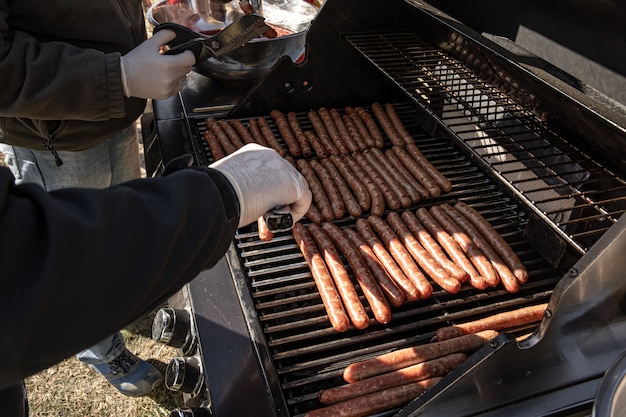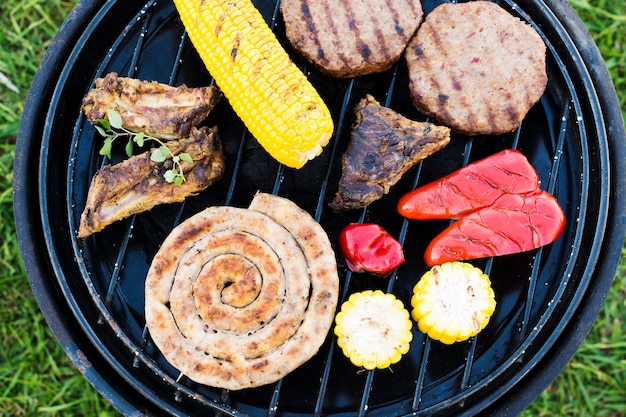Do I need to defrost sausages before cooking?
Sausages are a versatile and popular food choice in the UK. Whether you’re planning a hearty breakfast, a comforting dinner, or a tasty BBQ, sausages can be a delicious addition to your meal. But when it comes to cooking sausages, there’s often confusion about whether they need to be defrosted before cooking. In this article, we’ll explore the best practices for cooking sausages, including whether you should defrost them beforehand.
Yes, it’s recommended to defrost sausages before cooking
The general consensus among culinary experts is that it’s best to defrost sausages before cooking them. Defrosting sausages not only ensures even cooking throughout, but it also reduces the risk of harmful bacteria growth. When frozen sausages are cooked from frozen, the heat penetrates the sausages unevenly, resulting in potential undercooked areas or overcooked exteriors.
Defrosting sausages properly allows for a more controlled and consistent cooking process, resulting in sausages that are juicy, tender, and thoroughly cooked. It also helps prevent the sausages from drying out during the cooking process.
Methods for defrosting sausages
There are several methods you can use to defrost sausages:
- In the refrigerator: This is the safest method, albeit the slowest. Simply place the sausages in a covered container or on a plate and let them thaw in the refrigerator overnight. This gradual defrosting helps maintain the meat’s quality.
- In cold water: If you need to defrost sausages quickly, you can submerge them in a sealed plastic bag in cold water. Make sure the water is changed every 30 minutes to maintain a safe temperature. It usually takes about 1 to 2 hours for sausages to fully thaw using this method.
- In the microwave: If you’re in a hurry, you can defrost sausages in the microwave. Follow your microwave’s instructions for defrosting meat, ensuring that you do it on a low setting to avoid partially cooking the sausages.
Tips for cooking sausages
Once your sausages are defrosted, it’s time to cook them to perfection. Here are some tips to keep in mind:
- Preheat your oven, grill, or pan before cooking the sausages.
- Brush a little oil onto the sausages or the cooking surface to prevent them from sticking.
- Cook sausages at a moderate heat to ensure they cook evenly without burning.
- If using a pan, cook sausages over medium heat and turn them occasionally until they are caramelized and cooked through.
- For oven cooking, place the sausages on a baking tray and cook them in the center of the oven. Flip them halfway through to ensure even cooking.
- Use a meat thermometer to ensure the internal temperature of the sausages reaches at least 160°F (71°C) to guarantee they are safe to eat.
Remember, while defrosting sausages is recommended for the best results, it’s essential to follow proper food safety guidelines to prevent any risk of foodborne illness.
So, next time you’re planning to cook sausages, make sure to defrost them first for a tastier, safer, and more enjoyable meal. Whether you choose to thaw them in the refrigerator, in cold water, or in the microwave, taking the time to defrost your sausages will lead to a better culinary experience.
How soon do you have to cook sausages after defrosting?
When it comes to cooking sausages, proper defrosting is essential to ensure safe consumption and optimal taste. Defrosting sausages correctly can prevent the growth of harmful bacteria and help maintain their quality. So, how soon do you have to cook sausages after defrosting?
Defrosting sausages
When defrosting sausages, it’s important to avoid leaving them at room temperature for too long. The safest method is to thaw sausages in the refrigerator. Place the sausages on a plate or tray, covered with plastic wrap, and let them defrost overnight. This slow and gradual thawing process helps maintain the texture and flavor of the sausages.
Tip: If you need sausages to defrost quickly, you can use the defrost setting on your microwave, following the manufacturer’s instructions. However, it’s crucial to cook them immediately after defrosting to minimize the risk of bacterial growth.
Cooking sausages after defrosting
Once sausages are fully defrosted, they should be cooked as soon as possible. It is recommended to cook defrosted sausages within 24 hours of thawing to ensure their safety and quality. Leaving defrosted sausages in the refrigerator for an extended period may still allow some bacterial growth, which can lead to foodborne illnesses.
Quote: “To ensure the best results and eliminate any potential health risks, always cook defrosted sausages promptly.” – Food Safety Expert
If you’re unsure whether your sausages are still good to cook after defrosting, you can perform a sensory check. Look for any changes in color or texture, and give them a sniff to ensure they don’t have an off smell. If anything seems off, it’s best to discard them.
To summarize, defrosted sausages should be cooked within 24 hours of thawing in the refrigerator. If you need to defrost sausages quickly, use the defrost setting on your microwave, but be sure to cook them immediately afterward. Always prioritize food safety and quality when handling and cooking sausages.
Is it OK to defrost sausages in hot water?
Defrosting sausages is a common practice when preparing meals. While there are several methods available, one question that often arises is whether it is safe to defrost sausages in hot water. Let’s explore the advantages and drawbacks of this method.
Advantages of defrosting sausages in hot water:
Using hot water can speed up the defrosting process, saving you time when you need to prepare a meal quickly. Additionally, it can help maintain the texture and flavor of the sausages compared to alternative methods like using the microwave.
Drawbacks of defrosting sausages in hot water:
While hot water may be a convenient option, it is important to consider the potential safety risks. Hot water can create a breeding ground for bacteria if the sausages are not fully submerged or if the water temperature falls within the danger zone (between 40°F and 140°F).
It is generally advisable to avoid defrosting sausages in hot water due to food safety concerns. Instead, opt for safer methods which include defrosting in the refrigerator or using the defrost function on your microwave.
Food safety should always be a priority when preparing meals.
According to the UK Food Standards Agency, thawing frozen sausages in hot water is not recommended due to the potential for bacteria growth and the risk of uneven defrosting.
If you’re in a hurry, using the microwave to defrost sausages is another option. However, it is crucial to follow the manufacturer’s instructions and safely cook the sausages immediately after defrosting to prevent any potential bacterial growth.
Remember, safety comes first when handling food. By following recommended thawing methods, you can protect yourself and ensure the delicious sausages you serve are safe to eat.
Is it safe to defrost sausages in microwave?
Defrosting sausages in a microwave is a quick and convenient method, but is it safe? Let’s find out.
The microwave defrosting process
When defrosting sausages in a microwave, it’s important to follow proper guidelines to ensure food safety. The process involves using the microwave’s low power setting or the defrost function, which allows for more even thawing.
Here are some steps to follow when defrosting sausages in a microwave:
- Place the sausages on a microwave-safe plate or dish.
- Set the microwave to the low power setting or defrost mode.
- Defrost the sausages in short intervals, usually 1-2 minutes at a time.
- Rotate the sausages and check for any signs of overheating or cooking.
- Continue defrosting until the sausages are fully thawed but still cool to the touch.
Food safety considerations
It’s important to prioritize food safety when defrosting sausages in a microwave. Here are some key considerations:
- Even and thorough thawing: Make sure the sausages are evenly thawed to minimize the risk of bacterial growth.
- Avoid partial cooking: Be cautious not to partially cook the sausages during the defrosting process. This can lead to uneven cooking and potential foodborne illnesses.
- Proper storage: Once defrosted, cook the sausages immediately or refrigerate them if not using right away. Avoid leaving them at room temperature for too long.
“Defrosting sausages in a microwave can be safe if proper guidelines are followed, ensuring even thawing and preventing partial cooking.”
Alternative methods
If you prefer not to use a microwave, there are alternative methods for defrosting sausages:
- Refrigerator method: Place the sausages in the fridge overnight. This is the safest method for defrosting, but it requires more time.
- Cold water method: Seal the sausages in a leak-proof bag and submerge them in cold water. Change the water every 30 minutes until fully thawed.
Ultimately, the choice of defrosting method depends on your personal preference and time constraints. Just ensure that you follow food safety guidelines to avoid any health risks.



